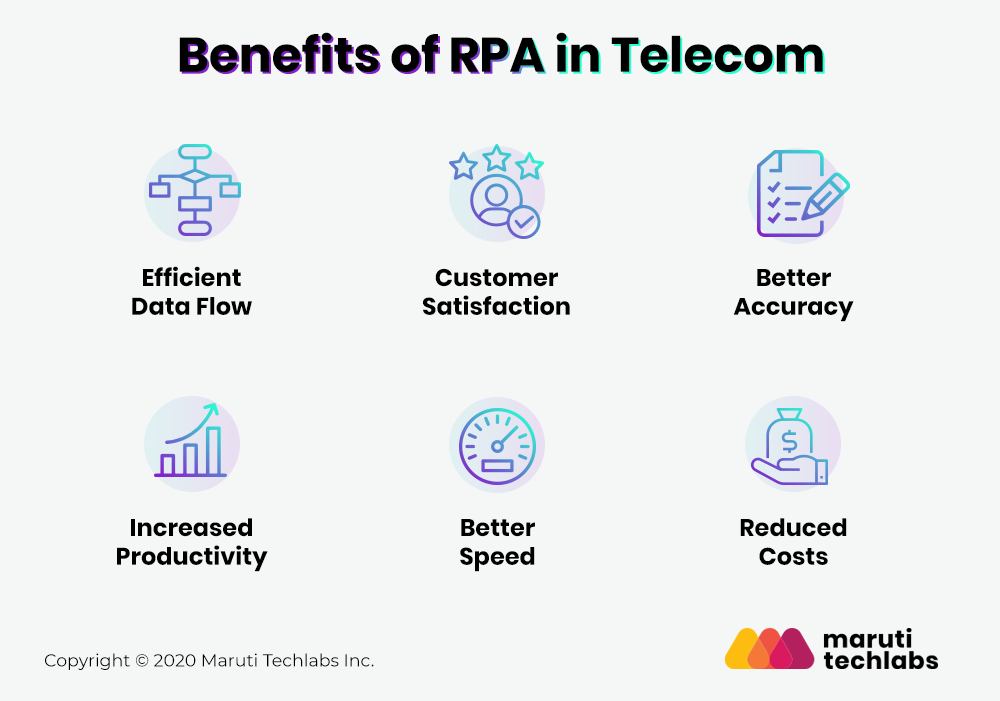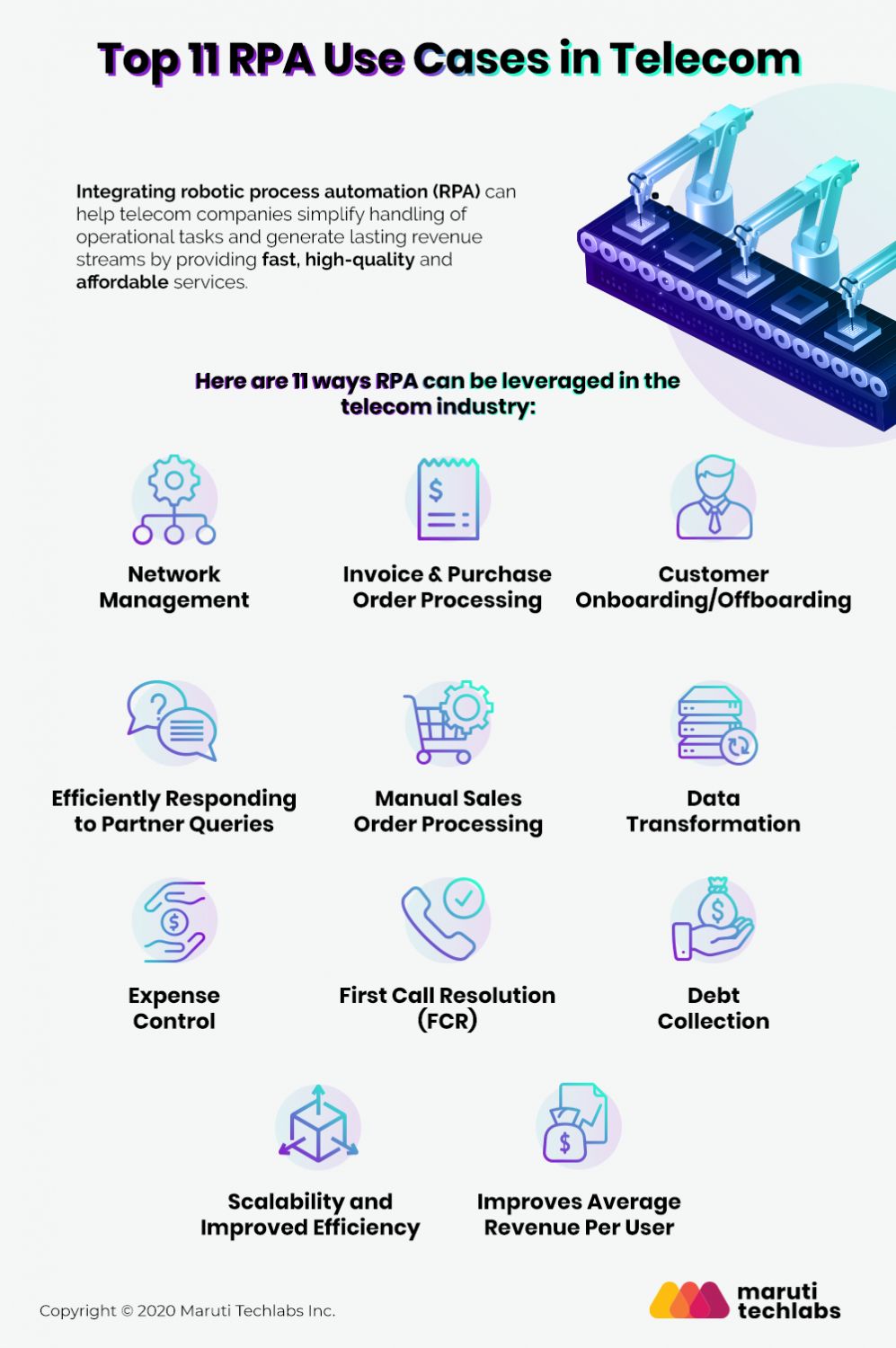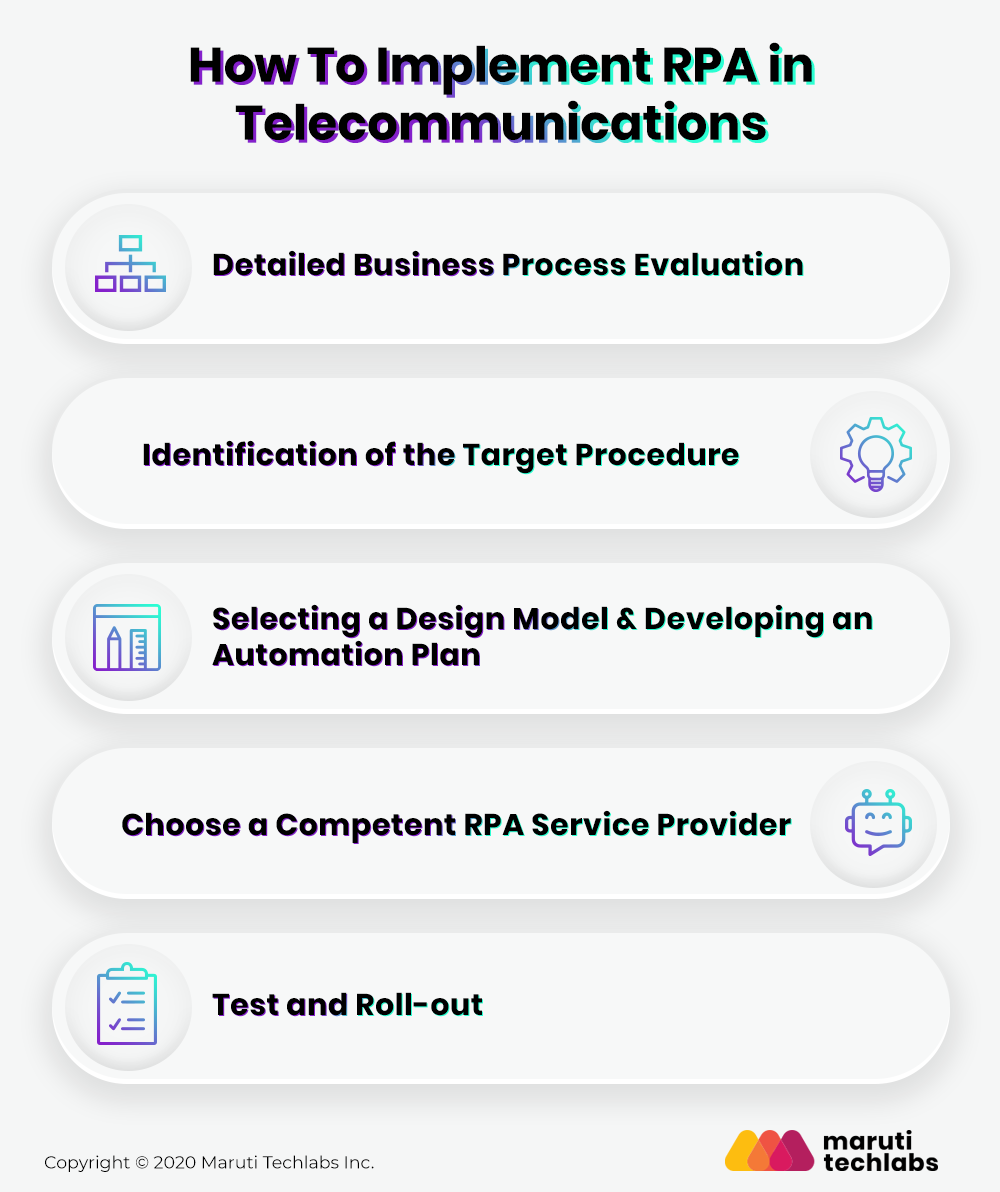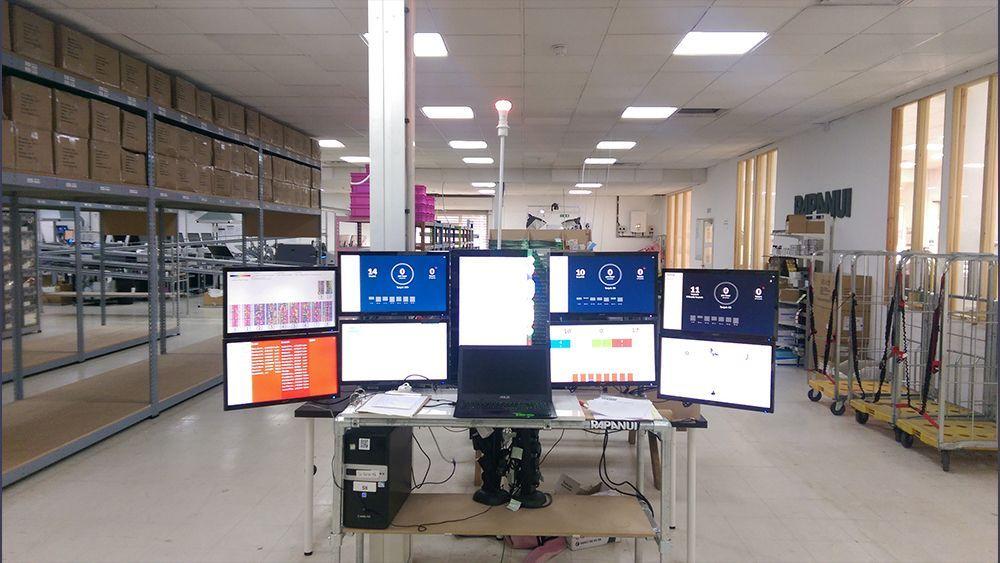Top 11 RPA Use Cases In Telecommunications - Automation in Telecom
Today, the telecom sector is a bit too familiar with challenges and difficulties. The ever-increasing demand for seamless connectivity, customized solutions, different range of products and services, skyrocketing levels of data to be handled, and cutthroat competition – all have burdened the telecom players. This is where RPA in telecom can come to the rescue.
We’re living in a digital era where more and more businesses and industries are automating their workflows and operations. A report by Forrester suggests that RPA will be worth a $2.9 billion industry by 2021. Integrating robotic process automation (RPA) can help telecom companies simplify the handling of operational tasks and generate lasting revenue streams by providing fast, high-quality and affordable services.
Why Opt for RPA in the Telecommunications Industry?
Telecommunications is a giant industry today where service providers are struggling with massive volumes of operational processes such as managing data, increasing business agility, controlling costs, improving business efficiency, and developing new models/services.
Operational services like customer support, billing, order fulfillment, and more have become increasingly complex and difficult to handle due to millions of subscribers, the clutter of customized plans, and customer segments. The repetitive processes prevent telecom service providers from focusing on other important tasks and their customers, making them compete with one another to provide affordable, fast, and cutting-edge solutions to their customers.
There are several other challenges that the telecom industry faces. Some of these are-
Low Productivity
Telecom service providers are known to handle massive amounts of data and are dependent on back-office staff to work on various platforms, systems, databases, and applications. With so many platforms working simultaneously, there is a need for a constant human intervention taking up employees’ quality time, thus reducing work productivity.
Further, there is a high chance for human error in such a scenario, along with increased turnaround time. For e.g., in the case of manual order creation and service removal processes, there is a huge challenge of removing specific services from the entire subscriber base.
High Overhead Expenses
Another challenge for telecom providers is managing high overhead expenses. These can be in the form of multiple software and hardware costs, maintaining data security, employee salaries, and much more.
Enhanced Risk of Errors
There are a number of activities in the telecom industry that are manual in nature with higher possibilities of errors. Some of these include rekeying data, updating data fields, and understanding information by going through the massive knowledge base. It can quickly lead to customer dissatisfaction as the correct information may not be readily available to them, taking up a lot of their valuable time.
How can RPA help?
Although many of the telecom companies are technologically equipped to meet these ongoing challenges, with changing times, telecom service providers require unique and innovative services to effectively navigate the transformational phase and fierce competition and ensure superior customer services.
The telecom industry is at a stage where it can take advantage of upcoming technologies such as Robotic Process Automation (RPA) to help them streamline their business processes. RPA allows telecom industries to automate different tasks across various systems, which are mostly labor-intensive and time-consuming.
Adopting RPA can help telecom businesses overcome several challenges to help their business operations and give them a competitive edge.
Benefits of RPA in Telecom
RPA use cases in telecom cover quite a lot of services such as on-time billing, payment processing, customer service, number portability, speeding up the document verification and SIM allotment process, data entry, data processing, data management, and much more. This leads to the many benefits as discussed below –

Efficient Data Flow
RPA (software robots) are capable of replicating human actions and can easily interact with the interface. In the telecom sector, RPA implementation can close the gap between data sources and access by offering specific data that a customer/staff needs. Further, the non-invasive nature of RPA makes it easy to implement it with existing workflows.
Customer Satisfaction
Using RPA in telecom, a number of back-office processes can be automated. It allows the employees to not get worked up with time-consuming back-office tasks, and focus more on client requests for enhanced customer satisfaction.
Better Accuracy
RPA based bots are fully programmed to follow manual routine processes. Equipped to work 24*7, they never get tired and work with 100% accuracy and consistency all the time.
Productivity and Speed
RPA technology takes care of all the routine and non-strategic activities and frees up employees from these processes so that they can completely concentrate on the tasks that need human intelligence. Further, bots are much faster compared to humans and can perform the same work in much less time.
Reduced Costs
Implementing RPA in telecom can offer the benefit of reduced costs as it can automate all the repetitive and time-consuming tasks performed by humans, thus lowering the labor cost and streamlining the processes.
Further, RPA in the telecom industry can also help the process of backing up client phone system configurations by managing hundreds of technical tasks to create a seamless backup system for all clients resulting in significant time and cost savings. Additionally, the cost of implementing an RPA solution is far less as compared to other automation solutions.
11 Telecom Use Cases for Robotic Process Automation
Telecommunication is one of the many industries that have some of the highest rates of adoption of RPA technology. Below are some of the RPA use cases in telecom –

1. Network Management
One of the challenging areas to tackle for telecom providers is capacity demand, as an increasing amount of rich content is constantly being transferred between apps, devices, and users.
With an increase in traffic levels and the complexity of distributed networks, telecom network management becomes difficult for service providers as it includes navigating complex applications, rekeying the data manually, and retrieving huge volumes of customer-related information to improve the efficiency of the network infrastructure.
Implementing RPA technology allows telecom providers to use automated solutions for repetitive tasks like incident, event, and diagnostics management so that network engineers can divert their focus towards more complex processes.
2. Invoice & Purchase Order Processing
RPA is a perfect fit for the telecom industry, as there are multiple repetitive organizational tasks that take time away from more efficient and productive ones.
By using software robots to conduct periodic maintenance work, monitor networks, keep backups, and distribute emails, RPA offers complete automation based on the complexity of the task. Further, RPA technology can be used in the telecom industry to digitize invoices and emails, helping the employees save their valuable time and focus their attention on better revenue generation strategies.
3. Customer Onboarding/Offboarding
Implementing RPA and automating the process of customer onboarding and off-boarding helps the telecom providers maintain robust clarity on all customers and their information.
Further, RPA powered bots make it super easy to add customers automatically whenever a new one joins and also simple to remove when they leave. It helps the telecom sector save time, reduce the chances of errors, reduce costs, and save their employees from wasting their time on unproductive manual tasks.
4. Efficiently Responding to Partner Queries
Most of the companies in the telecom sector rely on external partners such as independent brokers to sell their services.
RPA based software robots are fully equipped to respond to the simple queries, interpret emails, and redirect the complex questions to humans making the overall process of query resolution much simpler. Further, RPA also assists in customer service as it can automate call sharing to human employees instantly so that they can serve the customer immediately to ensure better work efficiency, increased profits, and overall enhanced customer service.
5. Manual Sales Order Processing
RPA in telecom can seamlessly capture all the business process tasks performed by the staff, thus minimizing the manual efforts required in sales order processing. This can be achieved by generating a well-structured workflow based on employees’ actions, which serves as an infrastructure for all the automated processes.
Further, telecom companies can map each process step with the cost associated with its manual execution to be able to identify the steps which need automation that can lead to the highest return on investment. This kind of robotic process automation in telecom is a good example of how it helps to manage large, unstructured datasets.
6. Data Transformation
This is another area where RPA in telecom can bring significant changes. The industry depends on huge sets of data stored in various file formats. RPA powered software bots can help transform all this data into a structured and uniform format, with an ability to work with non-standard formats of data as well.
Further, combining RPA with other upcoming technologies such as Artificial Intelligence (AI) can allow telecom providers to analyze predictive patterns based on structured datasets. RPA here can help organize the database, whereas AI can create predictions continuously with much higher accuracy.
7. Expense Control
RPA based software robots can be used for reducing operational and capital expenditures by maintaining robust data integrity and security, providing automated and regular reports, and managing software and hardware costs. It is especially suitable for small companies looking to benefit from significantly reduced costs. Additionally, RPA technology can also be used for billing and revenue management by automating those tasks.
8. First Call Resolution (FCR)
RPA technology enables software bots to rapidly access data, thus assisting the telecom agents in addressing the high volumes of customer demands on their first call without having to do repeated follow-ups.
Further, RPA promotes FCR rates, thus helping the telecom firms ensure customer retention and loyalty. Customer care processes with higher FCR rates lead to enhanced customer satisfaction and retention with lowered operating costs and happier employees for businesses.
9. Debt Collection
Automating the back-office process of debt collection can also be an effective RPA use case in telecom. RPA helps telecom firms to identify and collect what their organization is owed on the respective due dates. A robust RPA platform can automate various steps of the debt collection process, such as payment information updates, due dates, payment reconciliation, and urgent escalations. This helps the employees to be more productive by worrying less about the collection and more about the services they offer.
10. Scalability and Improved Efficiency
Managing the size and volume of the telecommunications industry requires cutting-edge technologies, and RPA, with its ability to handle large volumes of data, is the perfectly suited one. It allows for the automation of various back-office processes, thus eliminating the need for employees to do repetitive, mundane & redundant tasks and focus on other important work priorities.
11. Improves Average Revenue Per User
The average revenue per user is one of the main KPIs in the telecom industry to look for. By using RPA technology, telecom companies can identify sales opportunities by analyzing customer data and the customer’s eligibility for various promotions or sales campaigns while on an ongoing call, thus driving both cross-sells and up-sells. To have this information available at the time of the call, translate to better sales pitches, leading to increased closing rates and average deal size as well.
5 Steps To Implement RPA in Telecommunications
While robotic process automation (RPA) is completely taking the telecommunications industry by storm, organizations need to devise a strategic plan for its implementation to make the best use of it.
Here, we’re discussing a detailed plan that telecom service providers can use for RPA implementation –

1. Detailed Business Process Evaluation
To be able to get the maximum benefit of RPA in telecom and increase overall productivity, telecom firms need to begin by increasing the potential for automation. You can do this by evaluating every single task within a process based on its efficiency and effectiveness, followed by removing the ones which are not regulatory in nature and/or add no value to the business. The aim here should be to redesign the entire process to increase productivity.
For e.g., there are a number of traditional communication service providers (CSPs) still using the redundant steps such as the process step of verifying the order shipment. Ideally, these steps need to be removed from the process flow while implementing RPA.
2. Identification of the Target Process
When it comes to telecommunications, every process is made up of two parts -transactional and decisive. The processes involving various transactional parts are usually more adaptable for automation. To identify such processes, use parameters that involve high volume, high manual efforts, repetition and rule-based working.
3. Selection of a Design Model & Developing an Automation Plan
The next step in the RPA implementation should be redesigning the selected process flows in order to maximize their scope for automation. It is important here that process automation plans should be designed, keeping the overall business structure in mind and should be customized as per the process needs.
For example, if you’re choosing the process of call barring to be automated, the step of the bar removal verification process should be removed from the entire flow as it is of little or no use.
Once the design model is finalized, it is time to thoroughly analyze all the processes to identify the sections or parts that need urgent automation, don’t need automating, or will take time to automate.
4. Choose a Competent RPA Service Provider
When it comes to choosing a service provider for RPA implementation, it is preferred that you hire an RPA consulting and service provider with:
a) Required expertise in handling complex RPA projects
b) A complete framework with global standards to offer end to end process consulting and deployment through a professionally qualified workforce
c) Thorough understanding of operational challenges and CSP requirements
d) Tools to bring effective RPA implementation for client applications and telecom-specific process requirements
5. Test and Roll-out
The importance of the pilot phase, analyzing the efficiency, effectiveness, and performance of the automation plan cannot be overemphasized enough. The pilot phase is also important as it allows you to make improvements based on the testing phase.
The last step in the RPA implementation is to roll out the plan through the combined efforts of the IT department, business unit, and RPA solution provider. The aim here should be to deploy advanced automation solutions to optimize both front and back-office workflows for enhanced productivity and customer satisfaction.

Concluding Thoughts
The telecom industry is largely a function of different processes that are time-consuming and repetitive in nature but, at the same time, crucial for exceptional service delivery.
Further, the accuracy of process outcomes and high reliability are a must for telecom companies wanting to boost their productivity and customer service. And this is quite a difficult goal to achieve because of the usual preconditions of task fulfillment, such as the requirement of going through various systems to update them.
RPA adoption in telecom is a great approach to overcome many of these challenges and issues hindering the growth of telecom companies. The flexibility and ease of implementation of the RPA technology allow a wide range of operations to be automated for telecom providers. What this essentially means is that most of the back-office processes can be fully automated, and operations involving human interactions or reasoning can be partially automated using RPA.
All in all, RPA appears to be the perfect fit for the telecommunications industry as it continues to grow and develop on the global front. For years to come, these RPA use cases within the telecommunications domain will further grow leaps and bounds, creating multiple opportunities for technologies like these to make the necessary automation frameworks.
Know more about how RPA can fit into your business and help you gain an edge over your competition. Simply drop us a note here.




















